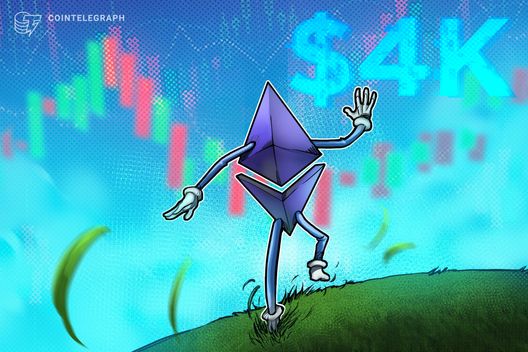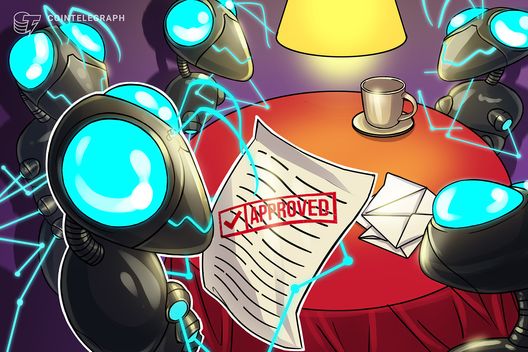
Die dreifache Bodenbildung könnte für den Ethereum-Kurs einen baldigen Aufschwung über 4.000 US-Dollar und höher bedeuten.

Finanzmittel Info + Krypto + Geld + Gold
Krypto minen, NFT minten, Gold schürfen und Geld drucken

Die dreifache Bodenbildung könnte für den Ethereum-Kurs einen baldigen Aufschwung über 4.000 US-Dollar und höher bedeuten.
The Uniswap Foundation has awarded blockchain infrastructure company Brevis a significant grant in efforts to fuel the adoption of its recent upgrade, Uniswap 4.
According to today’s official blog, the foundation plans to allocate up to $9 million to launch and manage an innovative Hooks Routing Rebate program.
The new initiative offers gas rebates to routers that have integrated v4’s hooked pool.
Notably, the grant aims to hasten Uniswap’s version 4 adoption.
The announcement indicated:
To accelerate v4 hook adoption and make aggregator integration more rewarding, Uniswap has awarded a grant to Brevis to leverage its ZK Data Coprocessor and zkVM to deliver trustless gas rebates to any routers that route order flow through v4 hooked pools.
🚀 @UniswapFND has awarded Brevis a grant to build a trustless gas rebate program for v4 routers!
Up to $9M in rebates for DEX aggregators integrating v4 hooked pools. All calculations verified by Brevis ZK proofs.
Here’s what we’re building 🧵 pic.twitter.com/7o4uLVPGCT
— Brevis (@brevis_zk) October 24, 2025
The decentralized trading protocol released its V4 update early this year, introducing advanced features like hooks – which are modules that developers can use to personalize liquidity pools.
Moreover, V4 launched a singleton infrastructure that merges pools under a single contract.
These upgrades introduced friendly fees, on-chain automation, and enhanced experience for decentralized application (dApp) developers.
Furthermore, v4 promised traders reduced slippage, lowered fees, and more efficient trade execution.
The January 31 blog read:
Beyond customizability, Uniswap v4 provides gas savings for both swappers and LPs. Creating new pools with v4 is up to 99.99% cheaper than in previous versions, and swappers can expect gas savings on multi-hop swaps.
Besides introducing new advancements, the upgrade brought new challenges for decentralized aggregators like Velora, 1inch, and 0X.
Decentralized aggregators are platforms that find the top trade routes by combining liquidity across different DEXs.
Previous versions had easier integrations.
For instance, Uniswap v2 adopted a constant-product approach, whereas version 3 amplified complexity through concentrated liquidity and fee tiers.
Nonetheless, v3 still ensures a consistent model.
Meanwhile, the much-awaited Uniswap version 4 allowed each pool to function independently based on the hooks it utilizes.
With that, hooks could introduce new execution ideas, apply special trading conditions, and adjust fees.
That offers the flexibility that boosts integration.
However, it made everything demanding and complex, as aggregators should familiarize themselves with how every personalized pool functions before using it to route trades.
That’s where the new rebate program by the Uniswap Foundation comes in.
The initiative allows the interoperable protocol to incentivize routers that integrate hooked pools successfully, offering up to $9 million in gas rebates.
Users will receive the rewards automatically according to their routing activity.
Meanwhile, these rebates can lower trading fees, fund ecosystem developments, and offset gas expenses.
The team said:
These rebates provide routers new economic relief to experiment with v4 hooks. Whether routers use them to offset their own operating costs, pass rebates back to traders as lower fees, or build sustainable treasuries, the result is the same: faster integrations, deeper liquidity, and better swap execution with reduced fees for users.
Uniswap’s native token, UNI, trades at $6.24 after an over 1% increase in the past 24 hours.
The post Uniswap Foundation (UNI) awards Brevis $9M grant to accelerate V4 adoption appeared first on CoinJournal.
XRP price has become the focal point of heated debate after the token slid roughly 15% over the past month while the Bitcoin price barely moved.
Market commentators and analysts are asking why XRP would suffer such a steep pullback when the broader market appeared comparatively steady.
The answer, they say, lies in correlation dynamics, liquidations, regulatory lag and nascent institutional activity.
In October, both Bitcoin and XRP rallied, with Bitcoin staying above the six-figure levels and XRP flirting with the $3 mark.
Profit-taking followed quickly, and altcoins absorbed most of the pain.
Traders who had piled into XRP were hit especially hard; one stretch of trading erased about $8.13 million of leveraged positions within four hours.
That sequence amplified losses and sent XRP below the $2.50 support level it had failed to hold after the upswing.
Charles Gasparino, a senior correspondent known for market coverage, spotlighted the paradox: Bitcoin fell only about 1% over the month, yet XRP plunged around 15%.
Why is BTC down 1 percent over the past month but XRP is down 15 percent?
— Charles Gasparino (@CGasparino) October 24, 2025
The contrast underscores a structural reality where XRP has historically tracked Bitcoin’s moves but with greater intensity.
When BTC stumbles or consolidates, that sensitivity can turn into outsized downside for XRP.
Beyond short-term mechanics, a longer-term narrative is reshaping investor expectations.
Analyst Zach Rector has argued that the launch of multiple spot XRP exchange-traded funds and similar institutional vehicles could effectively remove a substantial portion of circulating supply from the market.
According to Rector, that “supply shock,” Rector says, would create the conditions for a dramatic price re-rating, with conservative models pointing to targets ranging from $5 up to double-digit territory — even as high as $12 by December 2025.
🧵Final 2025 XRP Timeline 🧵
XRP November Pump Coming ✅
$5-$12 XRP by first part of December 🚨— Zach Rector (@ZachRector7) October 22, 2025
The regulatory backdrop also matters. Bitcoin and Ethereum have benefited from cleared paths to ETF adoption that flooded both markets with fresh capital.
XRP, by contrast, still faces an unresolved approval picture for spot ETFs in many jurisdictions.
That delay has likely depressed demand from risk-averse institutional buyers and made the token more sensitive to retail flows and sentiment shifts.
At the same time, data points show growing institutional interest via derivatives: CME-listed XRP and Micro XRP futures have recorded substantial contract volumes over recent months, a sign that professional desks are increasingly engaging the token.
From a technical analysis standpoint, the $2.30 area acted as a concrete support during mid-month liquidations, and the bounce to around $2.50 suggests buyers remain interested at those prices.

A sustained break above $3.40 would, in many analysts’ views, open a path toward $5.5, and if ETF-driven supply lockups occur, upside to substantially higher levels becomes plausible.
On-chain signals constructively complicate the picture.
The XRP Ledger is approaching a major transaction milestone, nearing 100 million recorded transfers.
That activity signals ongoing utility and adoption within payments and DeFi niches where XRP has carved a role.
Such resilience in on-chain throughput can buttress confidence even when price action looks shaky.
Assessing the path forward means weighing an array of forces: correlation-driven volatility, liquidation dynamics, regulatory clarity, and institutional adoption through derivatives and potential ETFs.
Short-term traders must manage the heightened risk that comes with XRP’s amplified moves.
Long-term investors, on the other hand, should watch ETF developments and on-chain adoption as the main levers that could catalyse the next leg of momentum.
The post XRP on the edge: from 15% slump to supply shock — is a $12 breakout next? appeared first on CoinJournal.
World, the digital identity project led by OpenAI CEO Sam Altman and formerly known as Worldcoin, has run into fresh regulatory trouble in Thailand.
Authorities conducted a raid on an iris-scanning location allegedly tied to the platform, underscoring how global scrutiny of biometric-based crypto projects is deepening.
Thailand’s Securities and Exchange Commission (SEC), working with the Cyber Crime Investigation Bureau (CCIB), announced on Friday that it had raided a site associated with “WLD exchange services.”
Investigators suspect the operator violated digital-asset laws by running an unlicensed exchange.
According to official data, World runs 102 “orb” locations in Thailand, where users scan their irises to receive a “World ID” in exchange for WLD, the project’s native token.
Each verified participant receives WLD as a reward for proving their human identity, but the SEC’s latest intervention raises questions about whether these operations comply with Thailand’s licensing framework.
The SEC and CCIB said the raid uncovered evidence that the site had offered exchange-related services without authorisation.
The suspect has been arrested and is expected to face charges under Thailand’s digital-asset regulations.
Authorities emphasised that any entity offering digital-asset services, including token distribution or exchange functions, must obtain a license from the Ministry of Finance and register with the SEC.
World maintains that it only operates in jurisdictions where its activities are legally permitted.
The company’s website states that “eligibility for WLD tokens is restricted based on geography, age, and other factors,” adding that it bears no responsibility for the trading of WLD on third-party centralised or decentralised exchanges.
This latest crackdown in Thailand adds to a string of global investigations into the World project, which launched in July 2023.
Regulators in Germany, Kenya, Brazil, and Indonesia have previously voiced data-privacy and licensing concerns.
In May, Indonesia’s Digital Ministry said it was investigating local World operators over possible registration violations and suspicious activities.
The company voluntarily paused its verification services there while clarifying licensing requirements.
In Germany, data-protection authorities have warned that biometric information, such as iris scans, could pose serious risks if not properly anonymised or stored.
Kenya temporarily suspended World’s local operations last year, citing privacy and security concerns after thousands queued for iris scans in exchange for free tokens.
Brazilian officials have also asked for greater transparency on how biometric data is collected and stored under World’s verification process.
Since its launch, World has positioned itself as an ambitious attempt to create a “global digital identity network,” verifying users’ humanity in an era of artificial intelligence and deepfakes.
The WLD token was designed to reward individuals who opt into the system and to build an ecosystem of verified human users.
Yet the project’s expansion strategy—particularly in developing markets—has raised alarms.
Critics argue that rapid onboarding in regions with weaker regulatory oversight exposes vulnerable populations to privacy and legal risks.
Despite these concerns, World continues to operate in more than 30 countries, relying on hundreds of orb devices worldwide.
Its website indicates that operations are constantly reviewed to ensure compliance with local laws, although recent raids suggest this process remains inconsistent across jurisdictions.
While Thailand’s SEC has not specified the scale of the suspected violations, the arrest signals a stronger enforcement stance amid the country’s broader efforts to tighten oversight of crypto-related businesses.
The development could push World and similar biometric-based crypto projects to adopt stricter compliance standards and clearer legal frameworks before expanding further in Asia.
The post Thailand raids Worldcoin-linked site as regulators intensify crypto scrutiny appeared first on CoinJournal.

Blockchain.com sichert sich eine Zulassung nach MiCA und ernennt Fiorentina D’Amore zur neuen Chefin für das europäische Geschäft des Krypto-Unternehmens.